 Next to the Mountaineers winning the NIT (okay, so it’s the tournament of losers…we won), the most exciting news in the world today is that our lil’ buddy Ian Moss is having his second annual Capital M world premiere extravaganza at Tonic next Wednesday. The concert will feature new works by Ian Dicke, Mike Gamble, Caroline Mallonée, Ian Moss, Edward RosenBerg III, Jonathan Russell, and Kyle Sanna. Noted provocateurs and ne’er-do-wells Anti-Social Music will follow with their particular brand of “punk classical” madness.
Next to the Mountaineers winning the NIT (okay, so it’s the tournament of losers…we won), the most exciting news in the world today is that our lil’ buddy Ian Moss is having his second annual Capital M world premiere extravaganza at Tonic next Wednesday. The concert will feature new works by Ian Dicke, Mike Gamble, Caroline Mallonée, Ian Moss, Edward RosenBerg III, Jonathan Russell, and Kyle Sanna. Noted provocateurs and ne’er-do-wells Anti-Social Music will follow with their particular brand of “punk classical” madness.
(A little early this week, as I might be out on the weekend) …Our regular listen to and look at compositions and performances that you may not know yet, but I know you should… And can, right here and now, since folks are nice enough to offer so much good listening online. Time to sit in on a few “first moments” in musical history:
George Gershwin & Paul Whiteman : Rhapsody in Blue – Original 78rpm Acoustic Recording (1924)
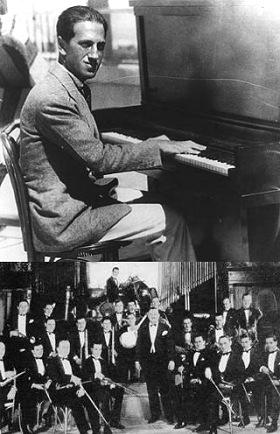 Made shortly after the premiere performance, and a year before the electric microphone came into use. The two records are on different pages: record one is here, and record two here. I can’t do any better than give B. Stockwell’s commentary from the Archive.org site:
Made shortly after the premiere performance, and a year before the electric microphone came into use. The two records are on different pages: record one is here, and record two here. I can’t do any better than give B. Stockwell’s commentary from the Archive.org site:
“This is an edited performance, with cuts made to fit the 15-minute work onto two 78-RPM discs. Total time is under 9 minutes, but the cuts are pretty smart ones. This work was originally written for a large dance band, the way you hear it here. This isn’t ‘Symphonic Jazz’. It’s authentic 1920’s style — completely different from the bloated ‘violins and cellos’ versions that we’re used to hearing. You can hear the banjos in this version. Gershwin plays the piano part and the performance is fast fast fast. The opening clarinet glissando wails and breaks off into reedy laughter. This is SO different from the the syrupy swooning you now hear. The sound isn’t spectacular — the microphone wasn’t invented until the next year, 1925 — but these 78s are still pretty well transfered. The recording of Rhapsody in Blue was a hit. In 1927 the same group — again with Gershwin but now with a microphone — made another recording. Paul Whiteman had a quarrel of some sort and walked out of the recording session. They recorded anyway, with another conductor — Nathaniel Shilkret, I think — taking over. Whiteman was happy to promote the recording as his own, nonetheless. The electric version is better recorded but it lacks, well, electricity. Everyone, including Gershwin, just punches it harder in 1924.”
———————–
Percussion Music from Lou Harrison’s Collection of 78rpm Acetate Records
 An absolutely fascinating audio document, this 1971 KPFA broadcast by Charles Amirkhanian presented extremely rare recordings of percussion music from the composer Lou Harrison’s (1917-2003) personal collection. Especially important are the acetate disks of a concert given by John Cage’s percussion ensemble at the Cornish School in Seattle on May 19th, 1939.
An absolutely fascinating audio document, this 1971 KPFA broadcast by Charles Amirkhanian presented extremely rare recordings of percussion music from the composer Lou Harrison’s (1917-2003) personal collection. Especially important are the acetate disks of a concert given by John Cage’s percussion ensemble at the Cornish School in Seattle on May 19th, 1939.
Cornish (still there and going strong; as a college student in 1978 I caught Cage himself at a tribute concert in the same hall, performing some of his Sonatas and Interludes) was where Cage found a job accompanying dancers, and it was there that he founded his first percussion ensemble and experimented with the prepared piano. (The stage in the Cornish performance hall was too small to accommodate all his percussion during a dance performance, so Cage came up with the idea of turning a single piano into its own percussion “ensemble”.) The performers heard include Cage, his then-wife Xenia, and the dancer Doris Dennison. (there has to be at least one more, quite possibly Lou Harrison himself. The photo here shows Lou, John, and Xenia behind, Doris and Margaret Jansen in front).
The pieces on these recordings represent the core of the West-Coast experimentalist group (I know, I know, Harry Partch; but he was off on his own very different journey): Lou Harrison’s Counterdance in Spring, Henry Cowell’s Pulse, two movements from Cage’s own Trio, Johanna M. Beyer’s Tactless and Endless, William Russell’s Three Cuban Studies, and again Harrison with his Fifth Simfony. You just can’t get much closer to sitting in on the roots of this exciting period.
The remainder of the broadcast features a 33rpm disk that captures a 1948 performance of Harrison’s Canticle #3, introduced and conducted by Leopold Stokowski during a concert at the Museum of Modern Art in New York City.
———————-
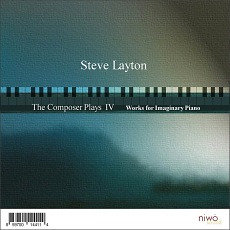 On a personal note, I’ll mention the release of my own new CD, The Composer Plays IV: Works for Imaginary Piano, on the NiwoSound label. Along with my performance of Stravinsky’s Piano-Rag Music, the CD collects a number of my works that feature piano: either solo, doubled, or with recorded sound.
On a personal note, I’ll mention the release of my own new CD, The Composer Plays IV: Works for Imaginary Piano, on the NiwoSound label. Along with my performance of Stravinsky’s Piano-Rag Music, the CD collects a number of my works that feature piano: either solo, doubled, or with recorded sound.
Jumping into the first wave of what I’m sure is to become common practice, no physical copy of the CD will be offered for sale in stores; it will only be available to subscribers at both eMusic and iTunes (the link is to eMusic; the CD is not “live” on iTunes yet, but will be soon — not only in the US, but iTunes Europe, Canada, Japan and Australia as well. iTunes folks can simply search “Steve Layton” to find the complete list of my available CDs in their country). For those who want something in their hand to read, complete liner notes for the CD can be had as a free downloadable PDF file (300 kb) from my own website. Enjoy!
It’s funny how our own personal preferences can make it so difficult to review concerts objectively. Take Monday night’s American Composer’s Orchestra concert, at Zankel Hall in New York – all seven pieces were good, often impressive, sometimes subtle and complex. But the things I want to rave about were not, I suspect, the things that most of the audience would have raved about when they got home.
Min Xiao-Fen’s Blue Pipa, for voice and the lute-like Chinese instrument named in the title, opened the concert effectively. Min performed the piece herself in a pool of light on an otherwise dark stage, and the combined vocal acrobatics and impressively virtuosic pipa playing made for a lovely and exciting piece. One audience member told me during intermission that it could have gone on for another five minutes and still been exciting.
Tania León’s Indigena combined the Cuban carnival music of her youth with quasi-tonal modernism in her trademark style. Her great skill lies in making this marriage organic—not so much seamless as deeply integrated, and never condescending to either tradition.
Speaking of integrative skill, Harold Meltzer’s Virginal performed the same feat with Renaissance stylings in a similarly modernist, quasi-tonal context. The contrapuntal music felt deliberate and rigorous in the same way that a 17th century fugue or an early 20th century serialist piece does.
But for all their virtues, and in spite of how well the audience liked them, none of the first three pieces excited me in the way that two sections of Vijay Iyer’s Interventions did. Perhaps a third of the way in, the orchestra drops out and Iyer, who was playing the largely improvised piano part, lets loose with a set of rippling riffs while pre-processed drum and hi-hat loops bounce back and forth in the speakers. I’m not convinced that the section really fit with the rest of the piece, but I have difficulty really minding. The piece’s long, static denouement was, for me, the heart of the piece. Most of the orchestra starts snapping their fingers in a steady slow rhythm, while the piano and strings give a long, droning, steady chord. It’s funny at first—you expect them to break into “boy, boy, crazy boy”–but as it continues the snaps reclaim their independence and provide an unusual sounding grid while the percussionist plays a slow pattern on a suspended cymbal. The cymbal patter sounds regular, but out of sync with the snaps, but if it was truly regular I couldn’t figure out the pattern. The overall effect was gorgeous and entrancing, and I didn’t want it to stop.
After intermission, Andrew McKenna Lee played his solo guitar piece Arabescata, which weaves together rock and classical language. It worked very well as a compliment to Blue Pipa from the first half—again sometimes pretty and sometimes impressively virtuosic. Kurt Rohde’s White Boy/Man Invisible was the least memorable segment of the concert for me, but as I recall the audience response was one of the most enthusiastic of the evening.
Rounding out the theme of integration of different musics, Steven Mackey played guitar for his Deal, a concerto of sorts for electric guitar and orchestra. Much of the first half of the piece didn’t engage me, although Mackey did a remarkably skillful job of combining the guitar with the orchestra in an organic way. As with Vijay Iyer’s piece, however, the final sections made the whole concert worthwhile. Most of the orchestra drops out, and Mackey sets up some looping grooves with his effects pedals against, surprisingly enough, recordings of what sounded to me like chickens, playing slowly evolving chords and countermelodies over it, building gradually over several minutes. By the time the orchestra came back, I was sold, but again it was some of the least spectacular music that did it. Maybe I just like the wrong things.
The nice folks at the American Music Center had a launch party for their latest cool initiative–Counterstream Radio–last night. If you haven’t checked it out yet, click on the toilet seat icon in the right column and some incredibly fine and varied music will follow you around the internets all day. Some members of the Counterstream team above, foreground: AMC president Joanne Hubbard Cossa, with Trevor Hunter, Lyn Liston, Lisa Taliano and Molly Sheridan. Sorry for the crummy picture, guys, and apologies to Frank J. Oteri and Randy Norchow whose picture didn’t work out at all.
Last night the Los Angeles Master Chorale gave the premiere of Requiem by Christopher Rouse. This is an excellent work. It is beautiful. It is emotional. It is powerful. It is dramatic, and it is peaceful. This is a Requiem that sets a standard for composers of the future while holding its own against compositions of the past.
Jerry Bowles gave us the link to the video recorded by Grant Gershon as summarized the work for his Board; it’s worth hearing again, so here’s the link. David Salvage reported Thursday on his interview with Rouse, so scroll down and re-read that. Rouse provided notes on the work for inclusion in the program; those notes are here. In addition, the program included these notes by Victoria Looseleaf. I encourage you to read them all.
Instead of trying to paraphrase what others have written so well, let me tell you what impressed me, just a set of individual thoughts and feelings without trying to bridge among them. Rouse gave us an exhilarating range of colors, tones and emotions. He found an emotional core within each section of the requiem, and he used his choral forces (and his percussion) to help the audience feel the content. He included his audience in the feelings and beliefs so that we were not merely sitting there listening to a ritual. I was grateful for the pause after the emotional power of the “Lacrymosa”. The demands on the chorus are huge; the work demands extremely good singers, and it provides compensation for the work. We could see the expressions on the faces of the members of the Master Chorale (101 last night) and the Los Angeles Children’s Chorus (57, I think). What focus and concentration. What joy, and pleasure, and relief as they stood there and had the waves of applause surround them. Sanford Sylvan was the excellent baritone soloist, handling the range of pitch Rouse asked of him while letting us understand the words. While the music Rouse gave him was less inherently interesting to me than his choral work, he was used to remind us of loss and the need for requiem. I really liked Rouse’s ending, in which the threads of the Everyman soloist and the choruses intertwine and, for the first time, the soloist sings the church verse while the chorus becomes the person dealing with loss and recovery. Gershon did a great job as conductor. Oh, I wish that last night’s performance was recorded. (There is word that KUSC-FM will broadcast the performance, and when I find out when the broadcast will be, I’ll submit a posting so that you can listen.)
Some final comments. If I were in New York, I’d make sure I have tickets for Thursday’s premiere of Rouse’s Wolf Rounds at Carnegie Hall. I don’t have enough Rouse recordings on my iPod; how could I forget what a good composer he is? If Requiem doesn’t win Christopher Rouse his second Pulitzer, there is one great piece out there still waiting to be heard. I thank Soli Deo Gloria and John Nelson for commissioning this work.
The Master Chorale and Grant Gershon really did a good job in communicating that this would be an important evening of music.
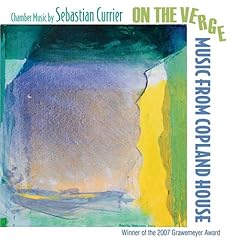 On the Verge
On the Verge
Chamber Music by Sebastian Currier
Music From Copland House
Koch International
With last year’s magnificent New World release Quartetset and this equally outstanding recording of four fairly recent chamber pieces (including the Grawemeyer-awarding winning Static), Sebastian Currier has elbowed himself into the honorary “little music” seat at the big table where the Glasses, Adamses, and Reichs go to chew the fat. So he’s a minaturist, but would Vermeer have been Vermeer on a Frank Stella-sized canvas?
Currier is something of a music jokester, with performance directions like “almost too fast,” “almost too much,” “almost too little” and “bipolar” but it is his uncanny ability to re-imagine music you think you’ve heard before that most frequently draws a smile and a sense of good companionship. Nobody since Stravinsky has done it better.
 Debut
Debut
Lowell Libermann
Trio Fedele
Artek
There is more than hint of powered wigs and petticoats in Lowell Libermann’s gracious, stately chamber music for ladies and gentlemen of quality. No 20th century angst here. Dvořák sounds like a wild man by comparison. The flute, cello and piano pieces are pleasant enough and expertly played by the Trio Fedele but I couldn’t help imagining a live performance where Borat would wander in with a plastic bag filled with poop and ask the cello player what to do with it.
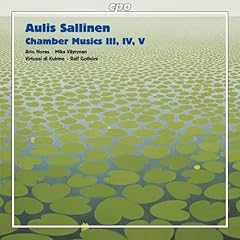 Chamber Musics III, IV, V
Chamber Musics III, IV, V
Aulis Sallinen
Virtuosi de Khlmo
CPO
Another music jokester but more in the William Bolcom tradition, relentlessly tonal and melodic, drawing mirth and drama out of genre references to tango and jazz. Easy listening? Sure. Nobody writing “classical” music today writes better hooks. That’s not necessarily a criticism in my book.
 Everybody likes to grouse about the weather, and East Coasters, who’ve moved to California, may expect sun 24/7. And though that’s never the case here in San Francisco, the climate, and especially the cultural climate on both coasts, does have one very definite thing in common — the dearth of welcome homes for new music, plus a congenial band to spread the word.
Everybody likes to grouse about the weather, and East Coasters, who’ve moved to California, may expect sun 24/7. And though that’s never the case here in San Francisco, the climate, and especially the cultural climate on both coasts, does have one very definite thing in common — the dearth of welcome homes for new music, plus a congenial band to spread the word.
New York has the long-running American Composers Orchestra, the S.E.M. Ensemble, and Bang On A Can, and the Bay Area, the San Francisco Composers Chamber Orchestra, which has been in operation for three years. Its March 10th concert at San Francisco’s Old First Church showed it going from strength to strength. A Springtime Romance fairly blossomed under music director and co-founder Mark Alburger’s careful, and for him, very relaxed guidance.
Katie Wreede’s 4 poem suite, from Robert Louis Stevenson’s Childrens’ Garden, began its life as a viola / soprano duo for the composer, and Lisa Scola Prosek, and joining them here was pianist Alexis Alrich as the third member of their Serafina Trio. Wreede’s settings suggested a kind of childrens’ candor, which Scola Prosek made irresistibly charming with her superlative diction and strong projection; Wreede and Alrich added their simple, flowing parts to the whole. Scola Prosek was represented with another section, Wedding Scene, from her to be performed at San Francisco’s Thick House opera, Belfagor, based on Machiavelli’s comic novella of the same name. SFCCO presented its overture, which features a big bass clarinet solo for Rachel Condry, last December; Condry beguiled with her tone as well as her mastery of her part’s manifold challenges.
The challenge for any theatre or film composer is to make whatever world they enter come alive convincingly as sound, and Scola Prosek’s instincts seem right on the money, whether that world is Periclean Athens, Imperial Rome, or Renaissance Italy, which she conjured “simply” yet effectively with rich sustained harmonies for her vocal quintet — sopranos Maria Mikheyenko and Eliza O’Malley; alto Gar Wai Lee; tenor Aurelio Viscarra; and bass bartone Micah Epps — and her orchestra, which launched the scene with a bright snappy fanfare. Loren Jones’ Dancing On The Brink of the World, San Francisco — 1600 to The Present–was effective–he obviously knows how deliver standard styles — but much less imaginative, while the middle, slow movement, of Alexis Alrich’s Marimba Concerto, which soloist Matthew Cannon played with polish and point, though not baldly eclectic, lacked an overriding sense of personal style.
Chris Carrasco’s The Mind Suite fortunately had one, though its Glassian homages, especially in the inner part writing for strings, were easy to spot and not that interesting, though he may develop — he’s very young — in surprising ways. The big surprise in fact was Erling Wold’s way tongue in cheek Baron Ochs, which despite a veritable melange of styles, still seemed to hang together, unlike his opera Sub Pontio Pilato, which stylewise seemed like a mad dash out the door in mismatched socks. He also seems to have gotten the knack of how to orchestrate effectively for every choir. The two seats I sat in — “stage left” aisle 6 — and the first row of the Old First’s balcony — seemed to offer the same sonic picture: warm music/ audience friendly balances when the scoring was chamber refined, and harsh congealed climaxes when it wasn’t.
Our regular listen to and look at living, breathing composers and performers that you may not know yet, but I know you should… And can, right here and now, since they’re nice enough to offer so much good listening online:
Katharine Norman (b. 1960 — UK, Canada)
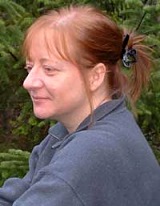 Katharine is a British-born composer, sound artist and writer, currently living about as far out West as you can get on Pender Island in BC, Canada. Prior to this “slightly alarming” (her words) change of direction she was Director of the Electronic Music Studios at Goldsmiths, University of London. She now supports the composing habit by freelance writing and some teaching. She’s composed instrumental music, music combining instruments or voices and digital media, and purely electronic work. Her music makes frequent use of documentary sound – conversation, city sounds, birds etc. – in a way that perhaps invites new appreciation both of the ‘real world’ and of the concert hall. Increasingly, she writes about music, in particular electroacoustic and electronic music. Her book of experimental writings on recent electronic music (of many kinds and approaches) entitled Sounding Art: Eight Literary Excursions through Electronic Music was published by Ashgate in 2004.
Katharine is a British-born composer, sound artist and writer, currently living about as far out West as you can get on Pender Island in BC, Canada. Prior to this “slightly alarming” (her words) change of direction she was Director of the Electronic Music Studios at Goldsmiths, University of London. She now supports the composing habit by freelance writing and some teaching. She’s composed instrumental music, music combining instruments or voices and digital media, and purely electronic work. Her music makes frequent use of documentary sound – conversation, city sounds, birds etc. – in a way that perhaps invites new appreciation both of the ‘real world’ and of the concert hall. Increasingly, she writes about music, in particular electroacoustic and electronic music. Her book of experimental writings on recent electronic music (of many kinds and approaches) entitled Sounding Art: Eight Literary Excursions through Electronic Music was published by Ashgate in 2004.
“I have been enthralled with sound as a means of expression ever since I discovered my violin playing made my parents cry (for all the wrong reasons). I started composing not long after, and in the last ten years or so have become more and more interested in the sounds that surround us, and what they can mean in different contexts. Although I remain fascinated by what computers can help me to do with sounds, technology is the least of my concerns – I’m trying to get somewhere, although happily the goal keeps moving. I’ll take whatever transport seems appropriate at the time, whether that’s works for sound alone, or piano pieces, or words on paper. But I will probably never write for solo violin.”
Katharine’s very welcoming site has a lot of peruse-worthy nooks and crannies, including some interactive pieces made especially for the web. The MP3 download section is being reworked, but luckily a lot of the recordings are parked at the SONUS website as well.
Ryan Brown (b. 1979 — US)
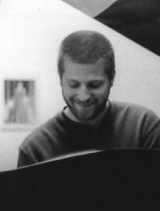 Ryan is a San Francisco-based composer and performer, most frequently combining the two in the “rock chamber ensemble” OOGOG. His formative years were spent playing rock and jazz guitar in various bands before beginning formal musical studies at the age of 17. These early years continue to heavily influence his approach to composition, “[pushing] the ensemble sound beyond the Western classical realm” (Josef Woodard, Santa Barbara News-Press). He holds degrees in composition from Cal State Long Beach and the San Francisco Conservatory of Music and has studied with Dan Becker, Robin Cox, Michael Gordon, Martin Herman, Scott Johnson, David Lang, Steve Mackey, and Julia Wolfe. Recent commissions include music for violinist Todd Reynolds and the SFCM Guitar Ensemble. His work our friend adam for alto sax, electric guitar, electric bass, and piano received its East Coast premiere on Philip Glass’ MATA Festival at the Brooklyn Lyceum on March 20th.
Ryan is a San Francisco-based composer and performer, most frequently combining the two in the “rock chamber ensemble” OOGOG. His formative years were spent playing rock and jazz guitar in various bands before beginning formal musical studies at the age of 17. These early years continue to heavily influence his approach to composition, “[pushing] the ensemble sound beyond the Western classical realm” (Josef Woodard, Santa Barbara News-Press). He holds degrees in composition from Cal State Long Beach and the San Francisco Conservatory of Music and has studied with Dan Becker, Robin Cox, Michael Gordon, Martin Herman, Scott Johnson, David Lang, Steve Mackey, and Julia Wolfe. Recent commissions include music for violinist Todd Reynolds and the SFCM Guitar Ensemble. His work our friend adam for alto sax, electric guitar, electric bass, and piano received its East Coast premiere on Philip Glass’ MATA Festival at the Brooklyn Lyceum on March 20th.
Ryan’s generous “downloads” page will give you all kinds of listening, including the MATA piece for all you East-coasties who stayed home. (Be sure not to miss hearing the maniacally demented boogie-woogie piano of Oogog Says Hello.)
 Consider this: Christopher Rouse does not compose every day; he starts every piece in full score, on measure one; he doesn’t use a piano much, because he can hardly play; he finds the entire process of composition miserable from start to finish and perennially aspires to artistic levels he believes he cannot attain; he only hears the bad things when his pieces get performed, and he is waiting for the day when people wake up and realize he’s no good.
Consider this: Christopher Rouse does not compose every day; he starts every piece in full score, on measure one; he doesn’t use a piano much, because he can hardly play; he finds the entire process of composition miserable from start to finish and perennially aspires to artistic levels he believes he cannot attain; he only hears the bad things when his pieces get performed, and he is waiting for the day when people wake up and realize he’s no good.
Rouse is, as in his music, unafraid to air his honest thoughts. He can appear neurotic and contradictory one moment, pragmatic and confident the next. He was so thoroughly interesting, I couldn’t resist trying to switch him before interview’s end to my own favorite topics: music and education. But we still had music to discuss.
Rouse has two upcoming world premieres: a Requiem (commissioned by Soli Deo Gloria, Inc.) and Wolf Rounds (commissioned by the University of Miami’s Frost School of Music). The former takes place March 25th at Walt Disney Hall in Los Angeles, the latter at Carnegie Hall on March 29th.
Rouse has been thinking about a Requiem for a while and all along the idea of interspersing the Latin liturgical text with secular poetry has inspired him. In his new work, he uses the secular texts to tell the story of a man’s encounters with death: a Seamus Heaney poem describes death from the perspective of the man as a ten year-old boy; a poem by Michelangelo mourns the death of the man’s father; a Siegfried Sassoon poem relates the suicide of a comrade in the trenches of World War I. These poems – and others – are sung by a solo baritone; the Latin is reserved for the chorus. Musically, Rouse organizes the work into an instrumental palindrome, building up from the opening unaccompanied baritone solo to the tutti “Tuba mirum,” and closing again with the solo baritone.
In Wolf Rounds Rouse gets the chance to rock out. The 17-minute work for symphonic band attempts to capture the rhythmic vitality and virtuosic energy of Rouse’s favorite rock music – most notably Led Zeppelin. Over a driving beat, instruments take up variations of the same melodic line; the close, quasi-canonic counterpoint calls to mind the circling of wolves around their prey. There are even some flutter-tongue trombone growls: mimesis, but also a nod to John Corigliano’s Symphony No.3 – another work for symphonic band.
Near the end of the interview, Rouse told me he was worried about his stage bow at Disney Hall. It takes 90 seconds to reach the stage from the balcony, and it was possible the applause might not last that long. The performers have assured him they will stretch the applause in the unlikely event such measures are necessary.
P.S. He’s also on MySpace.
Okay, I started making a list for friends called 13 great movies that you probably never heard of. Here’s what I’ve got so far:
1. Leolo (Canadian) Young French-Canadian kid named Leo believes his mother was impregnated by a Scilian tomato which is why he only answers to Leolo. And he’s the sanest member of his family. The filmmaker Jean-Claude Luzon died at 43 with his girlfriend when the Cessna he was piloting crashed but he lived long enough to tell Norman Jewison to go fuck himself when offered the chance to direct a Gene Hackman thriller and to tell Jamie Lee Curtis, a judge at Cannes, that he wanted to chew her up like a piece of liver.
2. Lovers of the Arctic Circle (Spanish) Directed by Julio Medem. Otto and Ana fall in love as children, become accidential brother and sister, become lovers, fall apart, and never quite find each other again, despite heroic efforts to that end. I’ve watched it six times and it breaks my heart every time.
3. Off the Map (American) Inept IRS man tracks down deliquent family in desert, falls in love with wife (who is standing naked in the garden) at first site, comes down with a fever, bonds with depressed husband, takes up painting and becomes famous at it although he doesn’t really care. Told from the perspective of the young daughter of the family.
4. Last Life in the Universe (Thai) Directed by Pen-Ek Ratanaruang. Suicidal Japanese librarian on the run from Yakuza moves in with Thai prostitute because there are two dead guys in his apartment.
5. Morvern Caller (Scottish) Lynne Ramsey’s second film (the first was the equally extraordinary Ratcatcher) stars the incredible Samantha Morton as a grocery store clerk who wakes up on Christmas morning to find that her boyfriend has killed himself in the kitchen, leaving behind the manuscript of a novel and the addresses of some publishers. She changes his name to hers and sends it in and then heads off to Spain with her girlfriend for a holiday.
6. Barbarian Invasions (Canadian) Directed by Denys Arcand. A fairy tale about dying not simply with diginity but with joie de vive.
Who has something to add to the list?